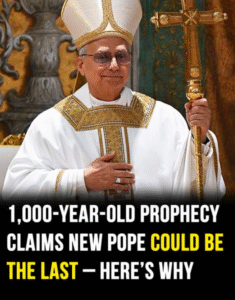The idea that Pope Leo XIV could be the final pope is stirring debate and fascination across religious and conspiracy communities alike, fueled by a chilling prophecy that dates back centuries. At the heart of the speculation is the Prophecy of the Popes, a document attributed to Saint Malachy, a 12th-century Irish archbishop. This prophecy lists 112 cryptic mottos, each said to describe a future pope. The final line references a figure known as Petrus Romanus (Peter the Roman), who is said to lead the Church through tribulations before its downfall or a time of great judgment.
Pope Leo XIV does not currently exist — the most recent pope as of now is Pope Francis. However, in some speculative theories or fictional accounts, Pope Leo XIV is imagined as the last pontiff, linked directly to the final line of Saint Malachy’s prophecy. Some believe that if a pope were to take the name Leo XIV, it would fulfill or at least symbolically align with the ominous message of the prophecy. This has triggered waves of online discourse, blending fact with speculation, fiction with fear.
The prophecy itself, while famous, is widely considered a forgery. Many scholars argue it was likely fabricated in the late 16th century during a period of political intrigue within the Catholic Church. The first 74 mottos — up to Pope Urban VII — are eerily accurate, while the rest become increasingly vague, leading many to believe the latter entries were either guesswork or later reinterpretations rather than divine foresight.
Still, the mystery and mystique surrounding the prophecy have made it fertile ground for apocalyptic theories. In today’s world, where global instability, moral conflict, and church scandals dominate headlines, many interpret the idea of a “final pope” as a metaphor for a crumbling institution. The figure of Pope Leo XIV, whether real in the future or symbolic, becomes a lightning rod for anxieties about the Church’s future.
Some even connect this imagined final pope to larger end-times narratives found in the Book of Revelation and various Marian apparitions, such as those at Fatima. Others point to real events like the declining influence of organized religion in the West, the rise of secularism, and ongoing internal divisions within the Vatican as signs that some sort of dramatic transformation — or collapse — may be imminent.
Despite the intrigue, the Catholic Church has never recognized the Prophecy of the Popes as legitimate, nor is there any doctrinal belief in a “final pope.” Still, the cultural power of prophecy — particularly when tied to religious authority and global events — continues to grip the imagination.
In the end, whether Pope Leo XIV will ever exist or fulfill some dire prediction is unclear. But the fascination with a final pope reflects deeper fears about change, legacy, and the enduring question of what comes after the end of an era. Could the Church endure a final reckoning? Or will it, as it has for centuries, simply adap
